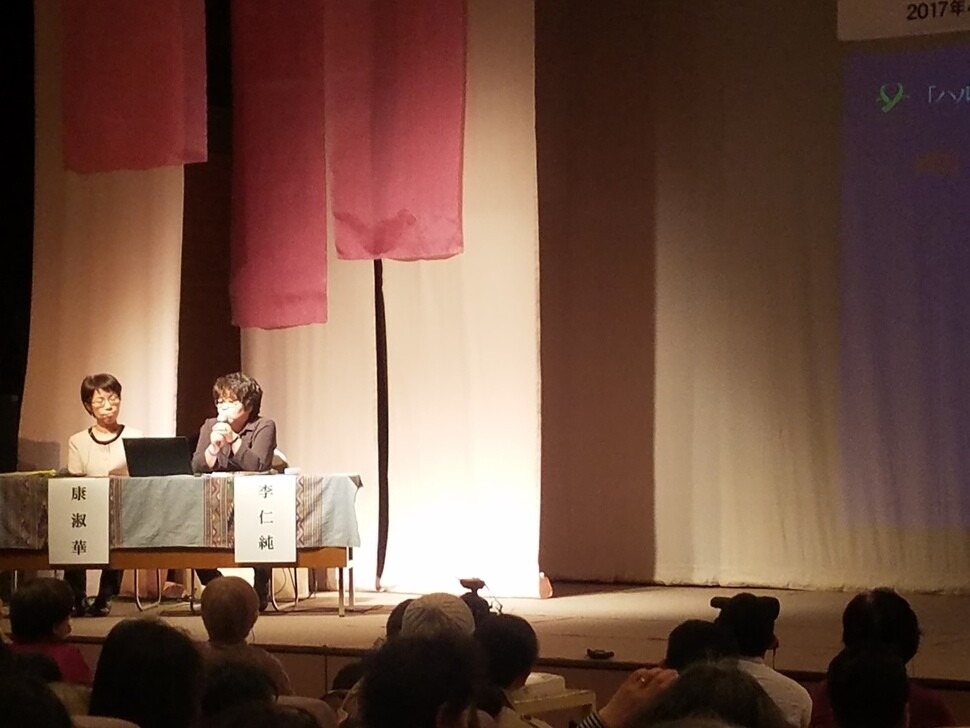hankyoreh
Links to other country sites 다른 나라 사이트 링크
Representatives of East Asian comfort women museums hold first meeting

“The Japanese government may be trying to erase history, but we cannot stop sharing the voices of the comfort women survivors. We have an obligation to share them with the next generation and the generation after that.”
Rechilda Extramadura of the Lolas Center, a comfort women museum in Quezon City, the Philippines, said that by preserving records related to the survivors, it may be possible to continue sharing their voices. She was speaking at the first comfort women museum meeting, held on Apr. 1 at the Zainichi Korean YMCA building Tokyo.
An inaugural meeting was held at the building that day for comfort women museums in South Korea, Japan, the Philippines, China, and Taiwan. The more than 100 seats in the venue turned out to be insufficient, leaving many to have to remain standing as they listened to the proceedings.
“Last year, when someone came from the Japanese embassy to the [Lolas Center] archive, I said, ‘No matter how much the Japanese government protests the comfort women museum to the Philippine government, it can’t stop these activities because they are being done by private citizens, not the state,‘” Extremadura recalled.
“I said that while the Japanese government may be trying to stifle the women’s voices, we can keep acquiring records and sharing them forever,” she added.
“Lola” is a Tagalog word meaning “grandmother.” Launched as a support center for comfort women survivors, the Lolas Center is currently joining in the effort to acquire survivor statements and photographs.
The Shanghai Comfort Women History Museum, which opened last year, described instances of at least one woman being dragged away to serve as comfort women while working as babysitter for a Japanese person. The Japanese employer turned out to be the same person setting up the “comfort stations.”
The Ama Museum in Taipei recalled that efforts to find a site for a comfort women museum first began in 2004, but failed for various reasons. It took 11 years of effort before the founders succeeded in 2015 in purchasing a 90-year-old building in Taipei. After some renovation, the museum opened last December. It currently holds statements and photographs for 59 Taiwanese comfort women survivors.
Director Lee In-soon from Heeum, a comfort women history center opened in Daegu in 2015, explained that the organization “came out of an association in the 1990s supporting comfort women survivors who refused to accept support from the Asian Peace Fund, which didn‘t acknowledge the Japanese government’s responsibility.”
“Back then, we thought the problem would be solved quickly, but it wasn’t,” Lee said. “Today, just five of the survivors who worked with us when we first started the support association are still alive.”
The Apr. 1 meeting ended with the adoption of a declaration.
“The Japanese government is trying to distort and forget history. The role of a museum sharing the reality and history of the comfort women’s victimization has become tremendously important for the next generation, not only in terms of education in peace and human rights but also to help the women recover from their victimization,” it read.
While the meeting was ending, five to six Japanese protesters outside the venue used loudspeakers to denounce the “hate speech.”
“It is shameful for [Japanese people] to claim our grandfathers did such serious things,” the protesters yelled, urging the meeting participants to “go to North or South Korea.”
By Cho Ki-weon, Tokyo correspondent
Please direct questions or comments to [english@hani.co.kr]

Editorial・opinion
![[Column] Park Geun-hye déjà vu in Yoon Suk-yeol [Column] Park Geun-hye déjà vu in Yoon Suk-yeol](https://flexible.img.hani.co.kr/flexible/normal/500/300/imgdb/original/2024/0424/651713945113788.jpg) [Column] Park Geun-hye déjà vu in Yoon Suk-yeol
[Column] Park Geun-hye déjà vu in Yoon Suk-yeol![[Editorial] New weight of N. Korea’s nuclear threats makes dialogue all the more urgent [Editorial] New weight of N. Korea’s nuclear threats makes dialogue all the more urgent](https://flexible.img.hani.co.kr/flexible/normal/500/300/imgdb/original/2024/0424/7317139454662664.jpg) [Editorial] New weight of N. Korea’s nuclear threats makes dialogue all the more urgent
[Editorial] New weight of N. Korea’s nuclear threats makes dialogue all the more urgent- [Guest essay] The real reason Korea’s new right wants to dub Rhee a founding father
- [Column] ‘Choson’: Is it time we start referring to N. Korea in its own terms?
- [Editorial] Japan’s rewriting of history with Korea has gone too far
- [Column] The president’s questionable capacity for dialogue
- [Column] Are chaebol firms just pizza pies for families to divvy up as they please?
- [Column] Has Korea, too, crossed the Rubicon on China?
- [Correspondent’s column] In Japan’s alliance with US, echoes of its past alliances with UK
- [Editorial] Does Yoon think the Korean public is wrong?
Most viewed articles
- 1‘We must say no’: Seoul defense chief on Korean, USFK involvement in hypothetical Taiwan crisis
- 2[Reportage] On US campuses, student risk arrest as they call for divestment from Israel
- 3[Column] Park Geun-hye déjà vu in Yoon Suk-yeol
- 4‘Weddingflation’ breaks the bank for Korean couples-to-be
- 5Korea sees more deaths than births for 52nd consecutive month in February
- 6N. Korean delegation’s trip to Iran shows how Pyongyang is leveraging ties with Moscow
- 7Amnesty notes ‘erosion’ of freedom of expression in Korea in annual human rights report
- 8Will NewJeans end up collateral damage in internal feud at K-pop juggernaut Hybe?
- 9N. Korean hackers breached 10 defense contractors in South for months, police say
- 10[Guest essay] The real reason Korea’s new right wants to dub Rhee a founding father